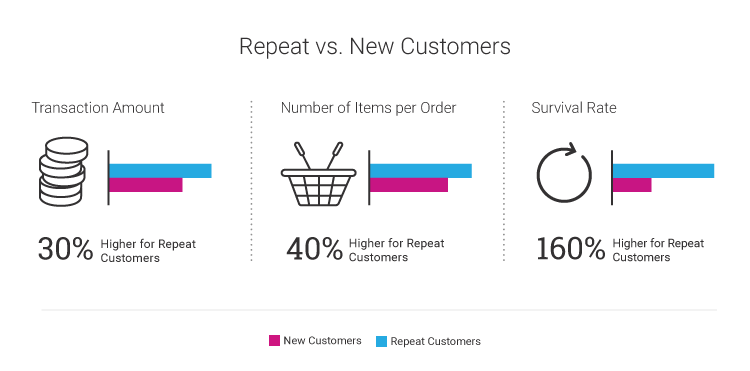
The Ecommerce Metrics You’re Not Looking at But Should Be
Revenue is the one thing that all businesses, big and small, track with pleasure (and maybe a little bit of fear). But there are lots of metrics that track growth and success, and if you want to see the whole picture, then you need to look at these as well. Here are five metrics that you should be following closely, and actionable steps you can take to see positive improvements.
1. Conversion Rate
Conversion is the percentage of people who complete the desired action. For instance, if you have 100 visitors to your site in one day and 12 of them make a purchase, then your conversion rate is 12 percent (12/100 = 12 percent), which would actually be quite high, so good for you 🎉! Conversion, however, isn’t just applied to sales, and it can be used to track any action, including the number of people who sign up for a newsletter or download an ebook, for instance. Here are some simple ways to improve conversion:
- A/B test everything, from headlines to calls to action to images to ads to promotions and more
- Create buyer personas to develop a strong understand of your customers
- Move your CTAs so they’re front and center, clear, and bold
- Use video and images widely
Here’s a great article on ecommerce testing ideas from our friends over at Optimizely.
2. New VS. Repeat Customers
It’s commonly known fact in business that it’s easier and cheaper to sell to existing customers than to go out and find new ones. But a business can’t survive on existing customers alone. You must strategically drive new customer through the funnel, while also focusing on keeping existing customers happy. As a business, if you can master driving a steady stream of new visitors and customers through the wonder of marketing automation tools and online advertising, you can focus a greater percentage of your time and effort on expanding a customer’s lifecycle to build a revenue foundation that is both profitable and predictable. Both new and returning customers are integral to your success, and increasing the numbers is all about increasing overall traffic to your site. That’s why the steps mentioned in ‘Converstion Rate’ are so essential for various other metrics to excel.
3. Website Traffic

Website traffic is the number of visitors that come to your site, and increasing traffic is one of those things that businesses are always striving to do. So without further ado, here are some tactics you can implement to help increase traffic:
- Be active on social media! Check what’s trending and engage
- Create lots of quality content, schedule it monthly and share it widely across your social channels
- Optimize all your content, including blogs, titles, images, and calls to action – even the old stuff!
- Use both short- and long-tail keywords to capture interest
- Advertise – we’re talkin’ Facebook, Twitter, LinkedIn or Google AdWords, figure out what’s relevant to your brand
- Use email and other forms of digital marketing
- Engage your audience through conversations and comments, be proactive and create a conversational community
- Build trust and authority by sharing content that’s exciting and relevant to your brand
- Create and use interesting videos and images that are high quality and fun
4. Average Order Size

Your average order size is exactly what it sounds like: the average value of all the orders your company receives in a given timeframe. You can calculate it by dividing your total revenue by the number of orders. For instance, if you had $500 of revenue in a week and there were four orders in total during that week, then your average order size would be $125. To increase your average order size, engage in marketing practices mentioned in ‘Website Traffic’ – get your brand out there!
Lots of businesses have tasked themselves with increasing average order size, and you can learn from them: create a threshold for free shipping, use coupons with minimum order thresholds, cross-sell, upsell, try a loyalty program, and create product bundles.
5. Abandoned Cart Rate
Your abandoned cart rate is probably around 77 percent, but don’t be alarmed: everybody’s is! Anytime a visitor comes to your site, adds items to a cart, and leaves without completing checkout, you’ve got yourself an abandoned cart. Here are some sure-fire ways to curb this:
- Don’t force shoppers to register
- Simplify your checkout process – the fewer steps the better
- Make return, shipping, and delivery policies easy to find
- Lower your shipping rates
- Offer multiple payment options
- Retarget abandoners with personalized content and offers
Investing in a proper analytics tool is extremely important to any business that has an online presence. If you truly want to understand your successes and problem areas, then it’s essential that you pay attention to these five metrics. Once you start tracking, there are plenty of tools and resources out there that you can use to make improvements where they’re necessary to drive growth for your ecommerce store.







Leave a Reply
You must be logged in to post a comment.